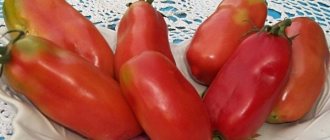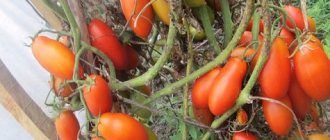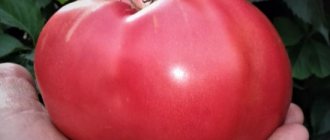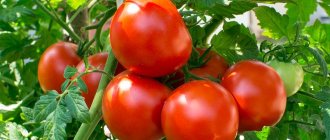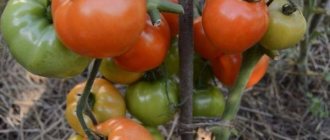Detailed description of the variety
Tomato Amber 530 is the result of the work of domestic breeders. The originator of the variety is Crimean OSS. In 1999, the hybrid was tested and included in the State Register of the Russian Federation. The Amber tomato is recommended for cultivation in all regions of Russia. The variety is suitable for planting in garden plots and small farms.
The Amber tomato ripens early. The period from germination to harvest ranges from 95 to 100 days.
Plant of indeterminate type. Gradually, the tomato stops growing; this does not require pinching the top. The bush is standard and has compact dimensions. The height of the plant is from 30 to 40 cm. It reaches 60 cm in width. The branching of the shoots is abundant.
The leaves are dark green, medium in size. The inflorescence is simple, first formed above the 8th leaf. The next ovaries appear every 2 leaves.
Brief description and taste of the fruit
Description of the fruits of the Yantarny variety:
- bright yellow color;
- round shape;
- weight 50 - 70 g, individual fruits reach 90 g;
- thick skin.
The Amber tomato is rich in carotene, vitamins and sugars. The taste is excellent. The fruits tolerate storage and transportation well. They are used fresh for salads, appetizers, first and second courses. Tomatoes are suitable for whole-fruit canning.
Amber 530 - variety of Tomato plant
Description of the tomato variety Yantarny
- tomato stalk with articulation;
- inflorescence simple;
- leaves are medium size, bright green;
- the shape of the fruit resembles a ball;
- the color is bright yellow or vaguely reminiscent of amber;
- the skin is thin and smooth;
- tomatoes are smooth and shiny;
- weight - no more than 70 g;
- The height of the bush does not exceed 30 cm.
Tomato variety “Amber 530” is universal. It is suitable for canning in general and for freezing. It can be added to first courses and salads. Regardless of the application, the sweetish taste and juiciness will not disappear, and the amount of vitamins after freezing or preparing tomato paste will only increase.
Advantages
The most common ones include:
- suitable for growing both in greenhouses and in open ground;
- is well stored and tolerates transportation;
- short ripening periods: 80-100 days;
- high yield: during the summer season, up to 7 kg can be harvested from 1 sq.m. tomato;
- all ovaries ripen at the same time;
- the bush is low-growing, which allows it to be grown in small greenhouses;
- immunity to many diseases that tomatoes often carry;
- resistant to adverse weather conditions (for example, temperature changes);
- cold-resistant;
- does not require tying or installing a support.
INTERESTING! The Amber tomato can be grown without seedlings - an ideal option for regions with unsustainable agriculture.
Flaws
The variety has no particular disadvantages, which is why many vegetable growers recommend that beginning gardeners start growing it. Among the small disadvantages, one can note only the small size of the tomatoes, which is completely offset by the taste properties and unpretentiousness of the variety.
Tomato variety Amber low-growing. The bush is standard, it limits its growth and branches weakly. Does not require removal of side shoots. Tomatoes form a compact root system, which allows you to grow more bushes per unit area. The plants have a strong stem and dense green leaves. The first brush is formed after the 5th sheet.
Taste qualities of fruits
The fruits of the Yantarny variety have a round shape. When technically ripe, tomatoes are yellow and may have a reddish tint. The weight of the fruit reaches 70 g. They contain an increased amount of sugars and carotene. Tomatoes are considered dessert tomatoes. The taste is good, the flesh is dense. The tomato tastes sweet. Sometimes a slight sourness is noted in the taste.
Advice! Tomatoes are used for canning. The sweet pulp goes well with marinades.
Features of cultivation
Like most early-ripening varieties, it is recommended to grow the Yantarny tomato through seedlings. Thanks to this approach, you can start harvesting at the end of June-July. Sowing varieties for seedlings is carried out as a standard 60 days before planting in the main place, and plant the seeds in March-April (seed planting depth is about 1 cm).
When sowing seeds, thoroughly level the soil and moisten it, cover the sown seeds on top with a thin layer of soil (about half a centimeter), cover the container with film or glass and place in a warm place. Usually shoots appear within a week.
As soon as the foliage begins to form (1-2 leaves are enough), pick the plants into separate pots. Planting in a common box at a distance of 7-10 cm is also allowed. You plan to plant it in a permanent place at the end of May - beginning of June (depending on climatic conditions).
Attention! For planting in a permanent place, light, moist, slightly acidic soil is most suitable.
Plant according to a 60 by 70 cm pattern; it will have a positive effect on the plant if you add 10 g of superphosphate to each hole when planting.
Then the care is quite standard:
- Timely and moderate watering. Advice! Water your plants with lukewarm water after sunset to help maintain humidity levels. Also remember that during the period of fruiting, the plant requires a sufficient amount of moisture.
- During the growing season, the plant requires loosening.
- Timely weeding.
Also don't forget about fertilizers. The first time the plant is planted, fertilize it when clusters of flowers appear. In this case, some use complex fertilizer or Nitrophoska (at the rate of 1 tablespoon per 20 bushes), when fertilizing, strictly follow the instructions, because excessive feeding can also harm the variety.
Pros and cons of the Amber tomato variety
Gardeners value the Amber tomato variety for its positive characteristics:
- The bushes are compact and do not take up much space. Plants do well in containers. Tomatoes are used for growing on balconies and loggias.
- The Yantarny tomato variety is suitable for growing without seedlings.
- Plants are determinate, so plant 6-8 plants per 1 m2. Thus, the tomato yield increases.
- Tomatoes are distinguished by friendly flowering and fruiting. Early ripening of the crop.
- Each tomato bush forms 5-6 bunches. After this, it stops growing and the fruits ripen.
- Even at low temperatures in the summer and prolonged rains, tomatoes set fruit well. Therefore, they are grown in the northern regions.
- The Yantarny variety is resistant to major diseases.
- Does not require pinching or gartering.
- The fruits are well stored and can withstand long-term transportation.
The tomato variety has no obvious disadvantages. Perhaps the small size of the fruit. Sometimes gardeners note the sour taste of tomatoes.
Resistance to diseases and pests
This variety is highly valued by vegetable growers for its resistance to macrosporum and late blight, as well as to adverse weather conditions. However, in order to prevent their occurrence, it is better to spray with special products that can be easily purchased at a gardening store.
To prevent pests from appearing, do not forget about simple measures:
- Preventive spraying with soap solution (moderate).
- Inspection for pests.
- And of course, simple hilling.
This way you can provide sufficient protection to the variety.
Agricultural technology of tomatoes Yantarny 530
It is recommended to grow tomatoes in seedlings. Seeds are sown 60 days before transferring to the ground. As a result of using this method of cultivation, ripe tomatoes are obtained in June.
Varietal characteristics
The Yantarny tomato variety brings a stable and high yield. Fruiting is early, the first harvest is harvested in July. Up to 2.5 - 3 kg of fruits are removed from the bush. Productivity per 1 sq. m is 5 - 7 kg. Fruiting is positively affected by care: fertilizing, watering, loosening the soil, choosing a suitable place for planting.
Advice! The Yantarny variety is suitable for regions of unsustainable agriculture.
Tomato variety Yantarny is grown in open and closed ground. The first option is chosen for warm regions and the middle zone. The Amber tomato tolerates cold and other extreme conditions well. Plants are not afraid of temperatures dropping to -1 C. In the northern regions of Russia, it is better to plant tomatoes in a greenhouse or greenhouse.
The Amber tomato is resistant to major diseases. High humidity increases the risk of infection with fungal diseases. Signs of late blight, spotting, and rot appear on leaves, shoots and fruits. The lesions look like brown or gray spots that quickly spread throughout the plants, inhibiting their growth and reducing productivity.
To combat diseases, Bordeaux mixture, Topaz and Oxychom preparations are used. Tomatoes are sprayed in the morning or evening. The next treatment is carried out after 7 - 10 days. To prevent planting, they are treated with a solution of Fitosporin.
Tomatoes attract aphids, spider mites, cutworms, and slugs. Pests feed on leaves and fruits of plants. The drugs used against insects are Actellik or Fundazol. Good prevention is annual digging of the soil and control over the density of plantings.
Pros and cons of the variety
The main advantages of the Yantarny tomato variety:
- early maturation;
- growing without seedlings;
- high content of nutrients in fruits;
- cold resistance;
- does not require pinching;
- immunity to diseases;
- good taste;
- universal application.
The Yantarny variety has no obvious deficiencies. The only downside for gardeners can be the small mass of fruits. If agricultural techniques are followed, then there will be no difficulties in growing this tomato.
Characteristics and description of the “Amber” tomato
Tomato Amber is a real find for lovers of healthy eating. The vegetable contains a large amount of useful vitamins and microelements that help the body recover after winter.
Read all about its beneficial properties, growing rules and features below.
Description and characteristics of the variety
- tomato stalk with articulation;
- inflorescence simple;
- leaves are medium size, bright green;
- the shape of the fruit resembles a ball;
- the color is bright yellow or vaguely reminiscent of amber;
- the skin is thin and smooth;
- tomatoes are smooth and shiny;
- weight - no more than 70 g;
- The height of the bush does not exceed 30 cm.
The main purpose
Tomato variety “Amber 530” is universal. It is suitable for canning in general and for freezing. It can be added to first courses and salads. Regardless of the application, the sweetish taste and juiciness will not disappear, and the amount of vitamins after freezing or preparing tomato paste will only increase.
Advantages
The most common ones include:
- suitable for growing both in greenhouses and in open ground;
- is well stored and tolerates transportation;
- short ripening periods: 80-100 days;
- high yield: during the summer season, up to 7 kg can be harvested from 1 sq.m. tomato;
- all ovaries ripen at the same time;
- the bush is low-growing, which allows it to be grown in small greenhouses;
- immunity to many diseases that tomatoes often carry;
- resistant to adverse weather conditions (for example, temperature changes);
- cold-resistant;
- does not require tying or installing a support.
Flaws
The variety has no particular disadvantages, which is why many vegetable growers recommend that beginning gardeners start growing it. Among the small disadvantages, one can note only the small size of the tomatoes, which is completely offset by the taste properties and unpretentiousness of the variety.
Features of cultivation
Like most early-ripening varieties, it is recommended to grow the Yantarny tomato through seedlings. Thanks to this approach, you can start harvesting at the end of June-July. Sowing varieties for seedlings is carried out as a standard 60 days before planting in the main place, and plant the seeds in March-April (seed planting depth is about 1 cm).
When sowing seeds, thoroughly level the soil and moisten it, cover the sown seeds on top with a thin layer of soil (about half a centimeter), cover the container with film or glass and place in a warm place. Usually shoots appear within a week.
As soon as the foliage begins to form (1-2 leaves are enough), pick the plants into separate pots. Planting in a common box at a distance of 7-10 cm is also allowed. You plan to plant it in a permanent place at the end of May - beginning of June (depending on climatic conditions).
Plant according to a 60 by 70 cm pattern; it will have a positive effect on the plant if you add 10 g of superphosphate to each hole when planting.
Then the care is quite standard:
- Timely and moderate watering. Advice! Water your plants with lukewarm water after sunset to help maintain humidity levels. Also remember that during the period of fruiting, the plant requires a sufficient amount of moisture.
- During the growing season, the plant requires loosening.
- Timely weeding.
Also don't forget about fertilizers. The first time the plant is planted, fertilize it when clusters of flowers appear. In this case, some use complex fertilizer or Nitrophoska (at the rate of 1 tablespoon per 20 bushes), when fertilizing, strictly follow the instructions, because excessive feeding can also harm the variety.
Resistance to diseases and pests
This variety is highly valued by vegetable growers for its resistance to macrosporum and late blight, as well as to adverse weather conditions. However, in order to prevent their occurrence, it is better to spray with special products that can be easily purchased at a gardening store.
To prevent pests from appearing, do not forget about simple measures:
- Preventive spraying with soap solution (moderate).
- Inspection for pests.
- And of course, simple hilling.
This way you can provide sufficient protection to the variety.
Reviews from those who planted
Beautiful, cute, beloved - I love this variety. Tasty, productive, easy to care for. I don't need more to be happy. I’ve been growing it for several years and couldn’t be happier, I even planted several bushes on my balcony a couple of times - they bore fruit!
An excellent variety that combines ease of care, good yield and versatility of taste. It doesn’t grow as my main plant, but I really like it. The whole family loves the delicious tomatoes that we add to salads and preserve!
For me this is a universal variety. Easy to care for, tasty, and begins to bear fruit early. I fell in love with it immediately, grew it for the second season and was not disappointed. This year I plan to grow the same.
The Amber tomato can be found both in the garden of a beginner and an experienced gardener, because ease of care and incredible endurance will allow anyone to get a rich harvest.
Rules for planting and care
Successful cultivation of tomatoes largely depends on proper planting and care. At home, seedlings are obtained, which are planted in a permanent place. The Yantarny variety also requires minimal care.
Growing seedlings
For tomato seedlings, choose boxes or containers 12 - 15 cm high. Be sure to provide drainage holes. After picking, the plants are planted in separate 2-liter containers. It is convenient to use peat cups for tomatoes.
Soil for seedlings is taken from a summer cottage or bought in a store. Any loose, nutritious soil will do. If soil from the street is used, then it is kept in the cold for 2 months. Before planting seeds, the soil is heated in the oven.
Tomato seeds are also processed. This will avoid seedling diseases and produce seedlings faster. Planting material is kept for 30 minutes in a solution of potassium permanganate. Then the seeds are washed with clean water and dipped in a growth stimulator solution.
Important! Amber tomato seeds are planted in March.
The procedure for planting tomatoes of the Yantarny variety:
- Moist soil is poured into the container.
- Seeds are planted to a depth of 1 cm. 2 - 3 cm are left between seedlings.
- The containers are covered with polyethylene and kept warm.
- The film is regularly turned over and condensation is removed from it.
- When the shoots appear, the plantings are transferred to the windowsill.
If peat tablets are used, then 2 - 3 seeds are placed in each. Then the strongest plant is left, the rest are removed. This method of planting will help you avoid picking.
Seedlings of the Yantarny variety are provided with lighting for 12 - 14 hours. If necessary, turn on phytolamps. When the soil dries, it is sprayed with a spray bottle. Tomatoes are protected from drafts.
When the seedlings have 2 leaves, begin picking. Each plant is transplanted into a separate container. First, water the soil, then carefully remove it from the container. Try not to damage the roots of the plants.
Transplanting seedlings
Tomatoes are transferred to a permanent place at the age of 30 - 45 days. This is usually mid to late May or early June. Such seedlings have reached a height of 30 cm and have 5 - 6 leaves.
3 weeks before planting in the ground, Yantarny tomatoes are hardened in the fresh air. First, open the window and ventilate the room. Then the containers are transferred to the balcony. This will help the seedlings quickly adapt to new conditions.
The soil for the crop is prepared in advance. Select an area where cabbage, onions, garlic, and root vegetables grew a year earlier. Planting after potatoes, peppers and any varieties of tomatoes is not recommended. In a greenhouse, it is better to completely replace the top layer of soil. In the fall, the soil is dug up and humus is added.
Tomatoes prefer light areas and fertile soil. The culture grows well in light and loose soils rich in nutrients. The addition of compost, superphosphate and potassium salt helps improve the soil composition.
Tomatoes of the Yantarny variety are planted according to a 40x50 cm pattern. Holes are prepared in the soil, which are watered and fertilized with wood ash. The seedlings are carefully removed from the containers and transferred to the hole along with a lump of earth. Then the soil is compacted and watered.
In warm climates, Amber tomato seeds are planted directly in an open area. Choose a time when it will be warm and frost will pass. The seeds are deepened by 1 - 2 cm, and a thin layer of humus is poured on top. The seedlings are provided with standard care: watering, fertilizing, tying up.
Planting care
Tomatoes of the Yantarny variety are unpretentious in care. Plants are watered 1-2 times a week and the soil is not allowed to dry out. Apply 2 - 3 liters of water under the bush. Moisture is especially important during the flowering period. When the fruits begin to ripen, watering is reduced to a minimum. Use only warm, settled water.
After watering, loosen the soil so that moisture is better absorbed. To reduce the number of waterings, the ground is mulched with a layer of humus or straw.
Attention! Tomatoes of the Yantarny variety do not grow. Due to their compact size, they are easy to tie up. It is enough to drive a support 0.5 m high into the ground.
In spring, tomatoes of the Yantarny variety are fed with slurry. The fertilizer contains nitrogen, which promotes the growth of shoots and leaves. During and after flowering they switch to phosphorus-potassium fertilizers. Instead of mineral fertilizers, wood ash is used. It is added to water before watering or incorporated into the soil.
Features of cultivation and storage
The seedlings are transplanted after the bushes are 55 days old.
Choose well-lit beds. They make sure that the soil is light and moderately fertile.
What are the secrets of caring for tomatoes:
- Regular moderate watering 2-3 times a week. Volumes and multiplicity are selected taking into account the humidity of the beds.
- Feeding. Mandatory at the flowering and ripening stage.
- The variety can do very well without pinching and fixing.
- "Agricola"
- "Agrofit"
- "Kemiru".
Balanced fertilizers provide a strong foundation for abundant harvests. For feeding it is recommended to use:
Bioinfusions, yeast solutions, diluted mullein and litter perform well.
Resistance to diseases and pests
This variety is highly valued by vegetable growers for its resistance to macrosporum and late blight, as well as to adverse weather conditions. However, in order to prevent their occurrence, it is better to spray with special products that can be easily purchased at a gardening store.
You may be interested in:
To prevent pests from appearing, do not forget about simple measures:
- Preventive spraying with soap solution (moderate).
- Inspection for pests.
- And of course, simple hilling.
This way you can provide sufficient protection to the variety.


